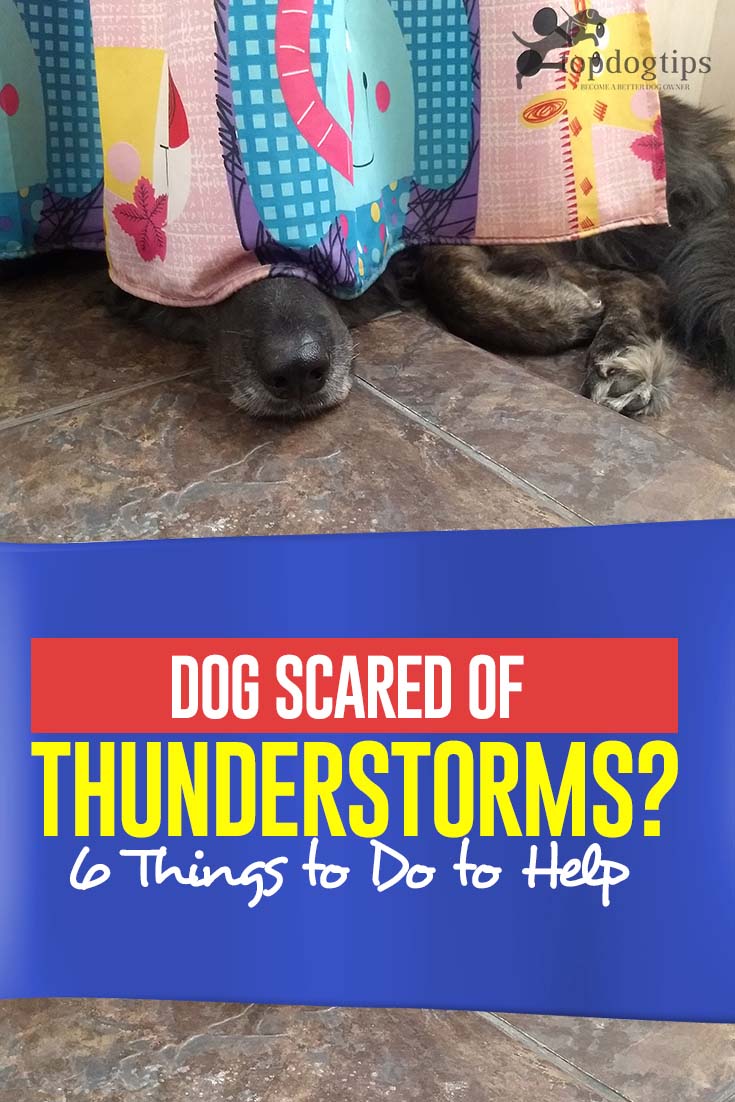There are a variety of reasons for why your dog may be scared or show fear during a thunderstorm.
Dogs can be aware of the changing atmospheric pressure as well as hear many sounds that they are not used to hearing, including wind, rain and thunder.
Dogs who are scared of thunder or storms may show their anxieties in a variety of ways.
In these “dark times,” most canines will whine, bark, hide, urinate on the floor, or show other anxious responses when a thunderstorm rolls through.
There are different ways that owners can help their dog stay calm and comfortable during a thunderstorm.
Here are six different things that you can do or provide to help reduce your dog's fears and help them remain comfortable during a thunderstorm.
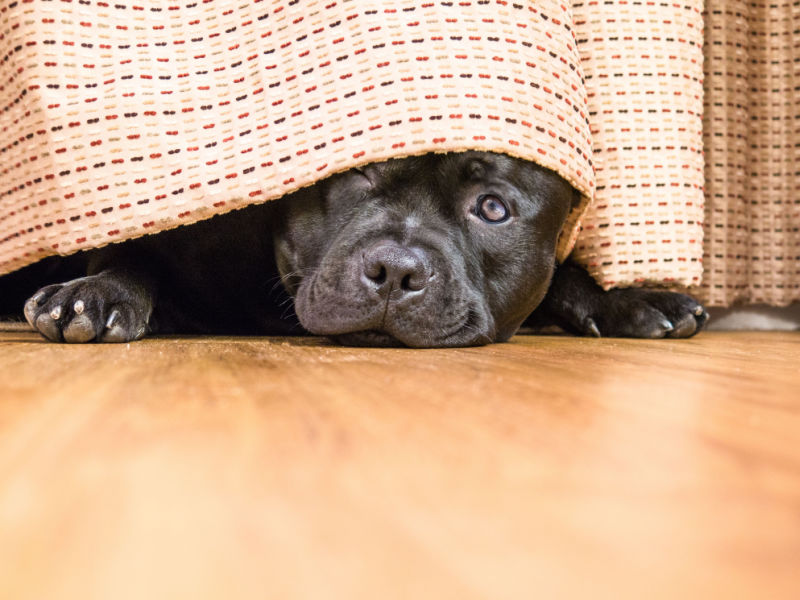
How Do I Know My Dog Is Afraid of Thunder?
This is something that you can tell without having to call your vet.
There are tell tale signs that your dog is afraid of thunder:
- Tail between their legs and ears pinned back
- Displaying fearful behavior like pacing around or running for cover
- They will start to pant, and excessively yawn or display lip licking
- It may turn into nervous destructive behavior like chewing on something they shouldn't
All of these signs are ways dog cope with feeling anxious and afraid.
3 Reasons Why Dogs Hate Thunderstorms
1. Thunder makes loud noises
First off, your dog's hearing is much better than yours. Which means they are more sensitive to loud sounds.
This one is obvious and not every dog is afraid of thunder.
For example, my dog Belle, DOES NOT have a thunderstorm phobia. She just lays there and sleeps when it very well maybe thundering outside our house.
2. Dogs can feel barometric pressure changes
Believe it or not, dog's can feel barometric pressure changes in the air.
So when a storm season rolls around and a storm changes the air pressure, they can feel it.
Now the change of barometric pressure on it's own won't cause them to freak out. It's usually paired with the loud noise of thunder outside that is shortly to follow.
The air pressure change followed by the rumbling can create a pattern that is easy for dogs to become afraid of thunder.
3. Dog's can sense static electricity that we cannot
Well if there is lightning there is probably some amount of static electricity in the air.
Like I mentioned before, dog's are sensitive animals.
Just like when your hair sticks to a balloon after rubbing it, your dog feels that over their entire body when a storm is going on.
This sensation, coupled with air pressure changes and loud thundering noises can easily make a dog afraid.
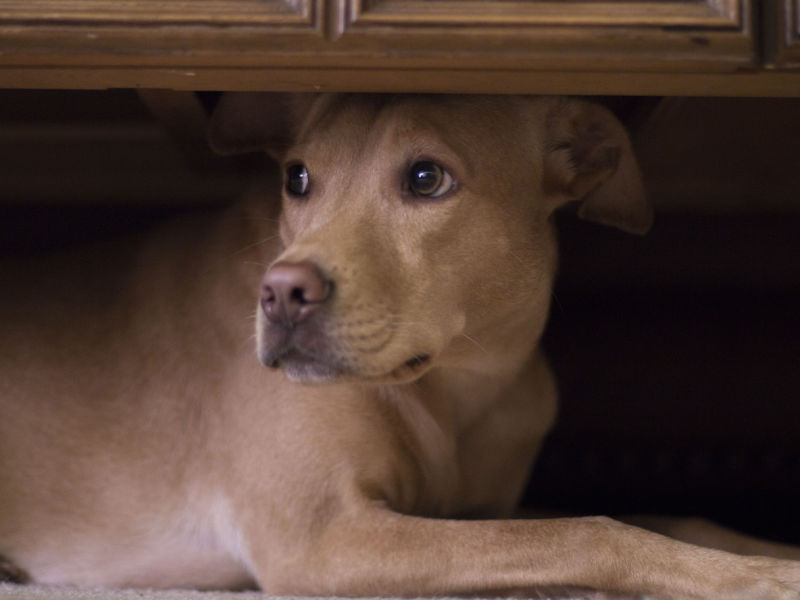
What Can Dog Owners Do to Help a Dog Afraid of Thunderstorms?
1. Offer Your Dog a Safe Space
One of the most helpful things owners can do for dogs who are frightened by thunderstorms is to provide a safe indoor space for them to go during the storm.
Some dogs like to be left alone when they are anxious and will look for a place to hide and feel safe whether or not accompanied by their owners.
A safe space for your pooch may include a dog crate, underneath a piece of large furniture such as a bed, the corner of a dark room, or other area in the home that they enjoy spending time.
Dark, confined areas are often comforting to dogs who are scared as it makes them feel safer and away from the scary sounds of thunder.
Never force your dog out of their preferred safe space.
Rather, allow them to seek out a safe space and preferably remain there with your pup until they are comfortable leaving the space.
You can offer your pup a familiar blanket or comfortable bedding for additional comfort.
If they are used to having a pillow or stuffed animal, make these items available, too.
Having familiar items available along with a comfortable area will ensure that your dog has a safe space with a familiar feel and smell that will comfort them.
2. Comfort Your Dog
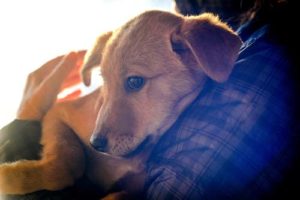
In addition to providing a safe space for your dog to go to when they are scared of a thunderstorm, offer them comfort, if they seek it out.
Not all dogs will hide during thunderstorms, so a safe place may not be their preferred way to seek comfort and it's been proven that dogs experience relief from fear when being as close as possible to their owners.
During thunderstorms, when your dog is showing fear and anxiety, it's crucial to avoid punishing them or using any time of negative reinforcement.
Instead, cuddle and maybe even hug your dog, pet them a lot, talk to them, allow them to sit on your lap or curl up by your feet.
When they are demonstrating that they are fearful, they need to know that they can go to you because with you or near you is one place where they feel safe(er).
By offering them comfort you will be able to reinforce that they are in a safe place and decrease their level of anxiety and stress.
3. Distract Your Dog
Providing your dog with some type of distraction is also beneficial to dogs during bad weather.
Keep in mind which toys or treats your dog loves to chew and play with, and which ones are most likely to keep his mind away from thunderstorm.
Save these special items for use during the storm.
For example, if your pooch has a favorite toy or bone that they really enjoy chewing over others, then use it as a distraction during the storm.
Try to use durable toys or long lasting treats as some storms can last for hours.
You do not have to stick to just one toy or treat either, you can rotate and switch between a few different toys or treats that your dog enjoys to help them stay occupied for the duration of the storm.
4. Use an Anxiety Wrap or Shirt
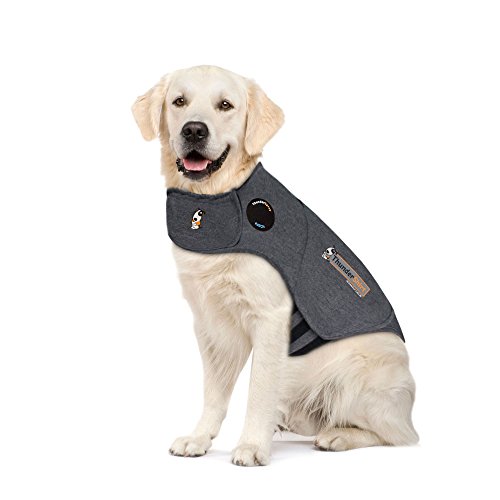
Some dogs need constant comfort during storms and this is not possible to provide all of the time.
It's been shown in studies that applying pressure on the dog's body provides them some relief from anxiety and stress, particularly during thunderstorms, fireworks, etc.
One product that can be purchased to help dogs with anxiety during storms or otherwise, are dog anxiety vests.
These vests/shirts, sold at pet stores and online, are snug-fitting clothing that provides an anxious dog with comfort by supplying constant pressure when the dog is wearing it.
The constant pressure can help comfort the dog and reduce anxiety.
The shirt or vest can be worn before, during, and even after the entire storm and does not interfere with the dog's ability to go outside and do their business.
5. Use a Whitenoise Machine
If it is the noise from a thunderstorm that bothers your dog (which is most often the case), try using a white-noise machine to help reduce or silence the thunder.
It's been proven in studies that dogs enjoy music, and some sounds help to calm them down.
The machines work by playing soft noises or sounds that drown out noises from outside, which is perfect in these cases.
Machines like this one come in a variety of sizes with different features, including the option to choose from a selection of noises such as ocean waves, static, soft music, and more.
Simply turn on the machine when there's a storm and allow it to run for as long as there is outside noise that bothers your dog.
These can be found online or in most baby sections of your local store.
6. Talk to Your Vet

Dogs scared of thunderstorms is not unusual, and it's one of the more common noise phobias many canines have.
But severe anxiety during thunderstorms that impacts your pet's life may require a trip to your dog's vet if the above options do not help alleviate their stress or their showing more severe symptoms such as hair loss.
Your dog's vet will be able to provide other solutions and treat any underlying issues that may be causing the dog to have difficulties during storms.
Be sure to provide your vet with the measures that you have taken to help your dog during storms.
This will give them the full picture of what happens during a storm.
The vet will then be able to provide you with the best advice as well as offer some other solutions to help your dog stay calm during thunderstorms, some of which may include anti-anxiety medications.
7. Get In Touch With A Dog Trainer or Veterinary Behaviorist
The last option is something you would do pre-emptively before a storm or storm season.
You'd also pick this option if your dog's fear is so great that nothing you have tried has been able to calm them down.
I don't need to tell you this, but storm anxiety real and having a dog with a storm phobia can be difficult to manage.
Using a trainer or behavior modification like positive reinforcement can teach them that there is nothing to be afraid of.
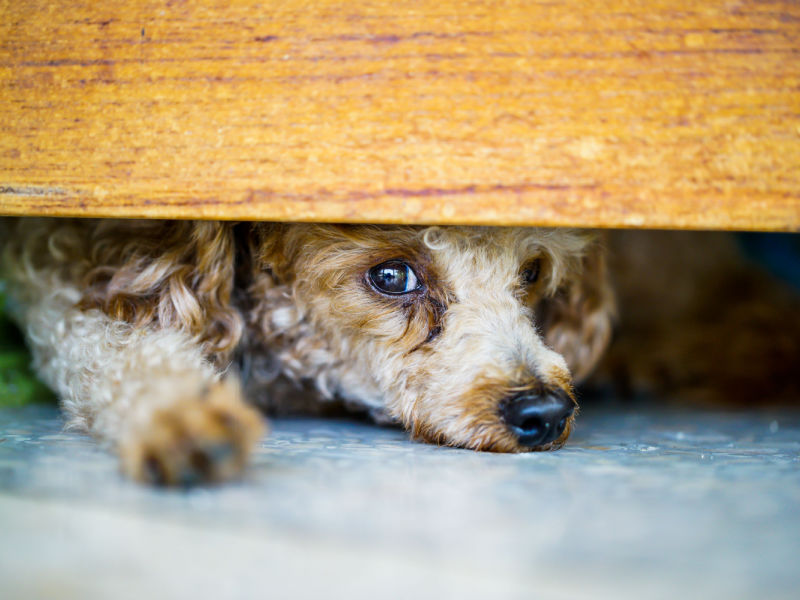
FAQs
Can a dog be traumatized by thunderstorm?
Yes, it is very easy for a dog to be traumatized by anything it fears if the encounter is scary enough for them.
Should you ignore dog scared of thunder?
No, in fact, the best thing you can do for a dog's fear of thunder is make sure they have somewhere that makes them feel calmer.
This means a place with blankets that have smells they like, their toys, and maybe some treats involved for being calm.
The last thing you want to do is punish your dog for being afraid of thunder. This can make their thunder phobia worse.
Now You Know How to Help a Scared Dog During a Thunderstorm
In conclusion, when the thunderstorm hits, provide a safe space for your pup, offer comfort and distractions during the storm, and stay with them.
Try some soothing products such as an anxiety vest or white-noise machine.
Finally, if these things do not help, visit your vet for a thorough examination and additional solutions like anti-anxiety medications.
Each of these steps can be implemented one at a time, or you can offer a variety of these solutions to your dog to help find relief sooner rather than later.
READ NEXT: Dog Scared of Fireworks? 7 Things You Can Do to Help
Disclosure: We may earn affiliate commissions at no cost to you from the links on this page. This did not affect our assessment of products. Read more here and find full disclosure here.


